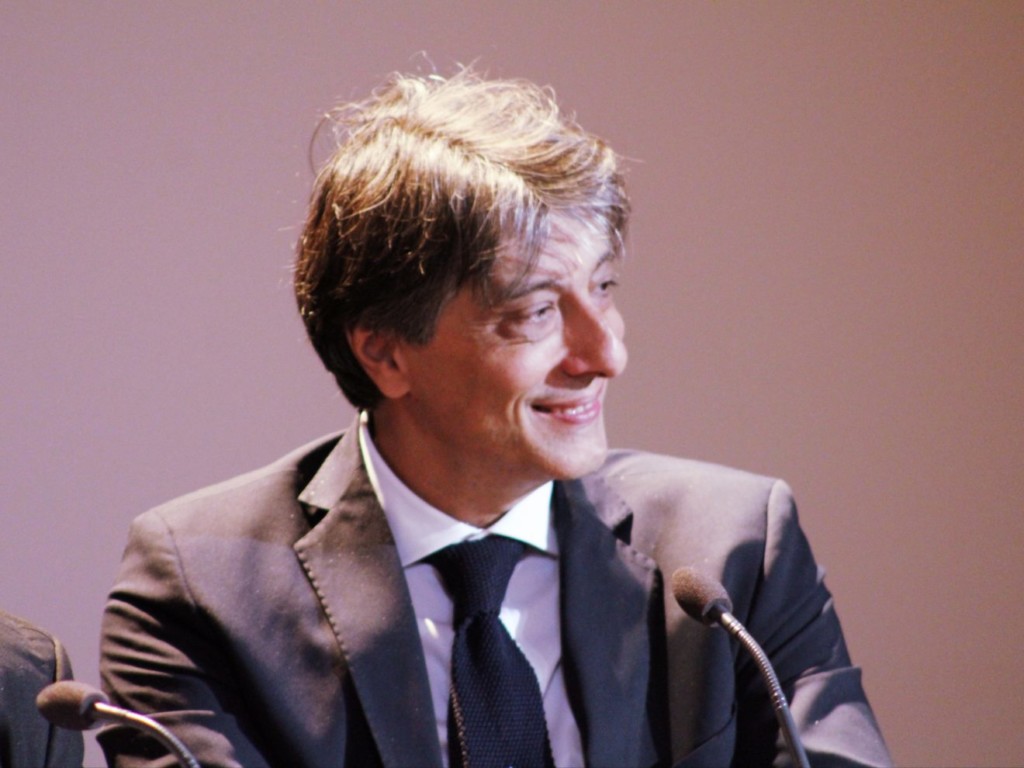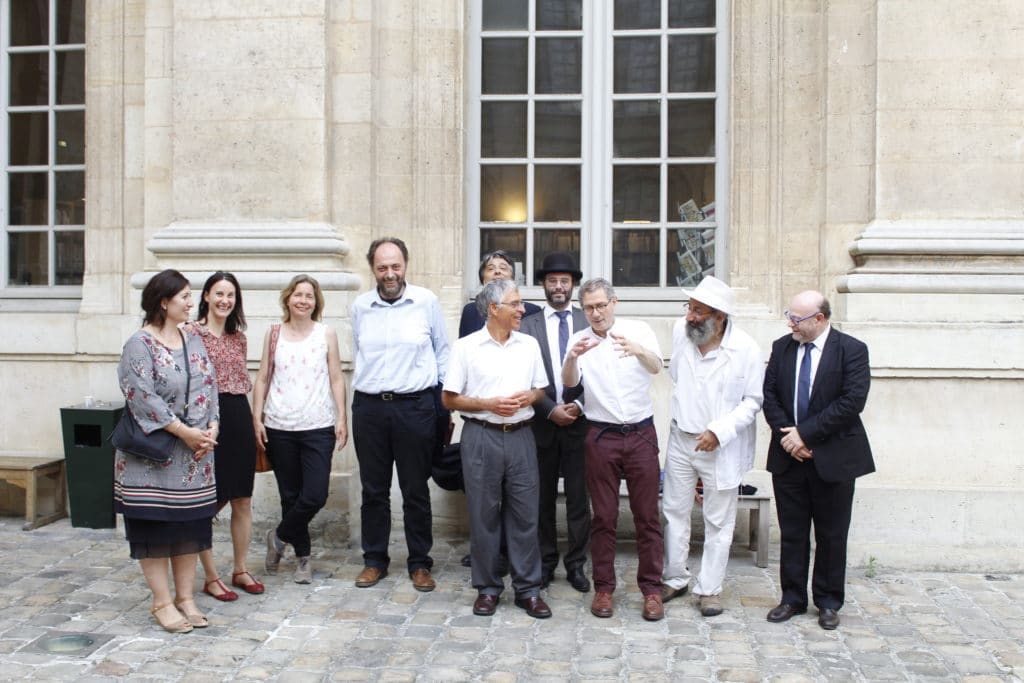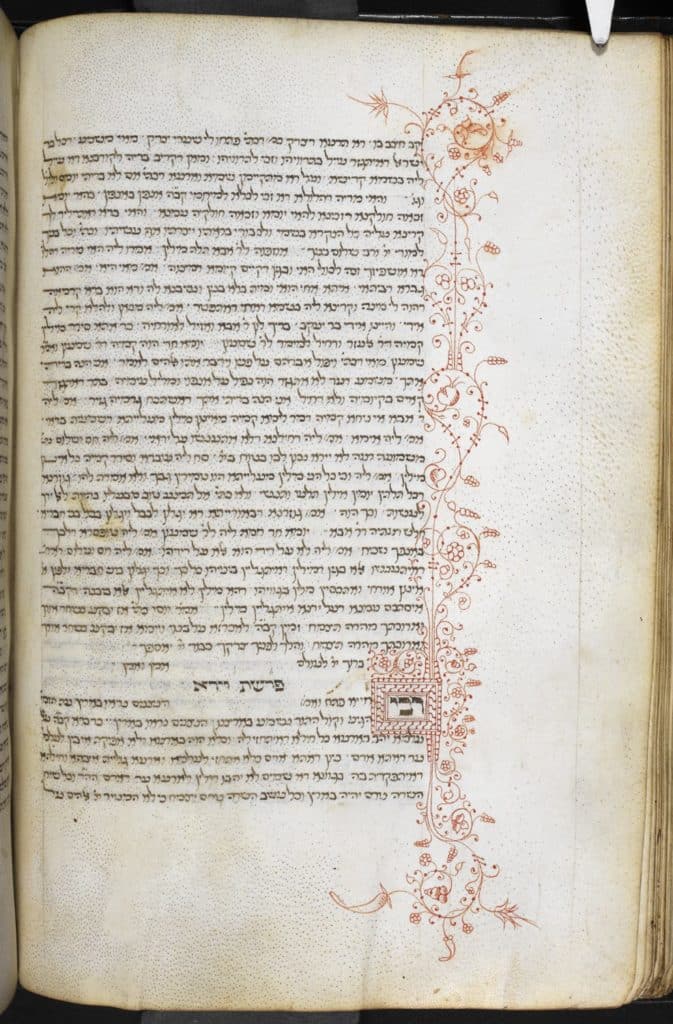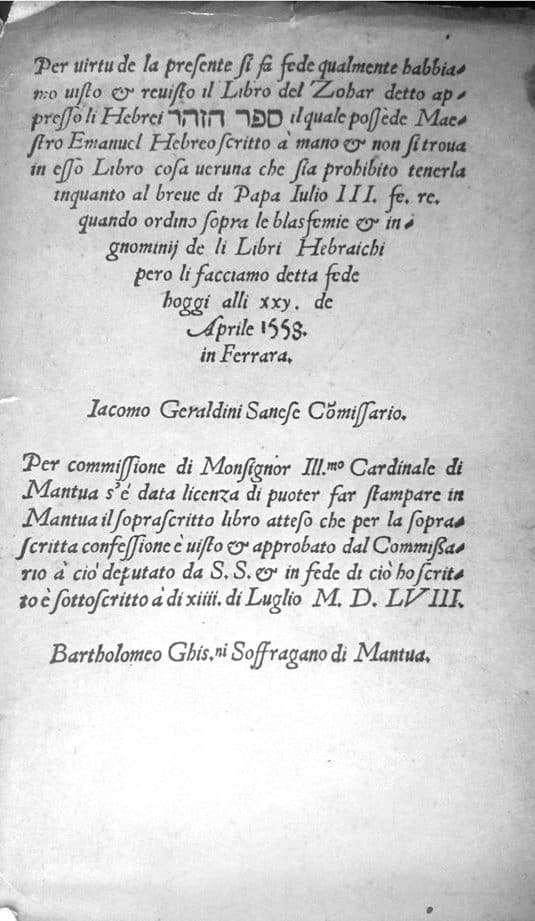Cette publication est également disponible en :
Français
The impact of the Mantua Zohar edition on Early Modern Jewish society1 I am indebted to my colleague and friend Raphael Ebgi, for having generously shared with me his notes on the Alphonsine Renaissance and its influence on the Zohar. Dr. Ebgi is presently working to a larger project on the setting of the Zohar in Medieval romance literature. is clearly noticeable and has already been the subject of several scholarly studies2On the cultural significance of the publication of Kabbalistic works, and especially of the Zohar , see I. Tishby, Studies in Kabbalah and Its Branches [en hébreu.] , Vol. 1, Jerusalem 1982, p. 79-130. As Tishby pointed out, it is true that there is no direct relationship between the burning of the Talmud ordered by Pope Julius III in 1553 and the decision to print mystical texts. However, there is no doubt that the need to reinforce the “power of endurance” of Judaism, also through texts previously considered secret, was an answer to the material and cultural attack which the Counter-Reformation Church launched against the Jews. On the debate concerning the printing of cabalistic texts in the xvi e century, see S. Assaf, “Le-Fulmus al Hadpasat Sifre Qabbalah”, in, Meqorot u-Mechqarim , Jerusalem 1946, p. 238-246; Ring, Mi-Paulo ha-Revii ad Pius ha-Chamishi , Jerusalem 1954, p. 132-136; A. Yaari, Studies in Hebrew Booklore [en hébreu] , Jerusalem 1958, p. 216-219; D. Tamar, Studies in the History of the Jewish People in Eretz Israel and in Italy [Héb .] , Jerusalem 1986, p. 164-165; G. Busi, Mantova e la Qabbalah: Mantua and the Kabbalah , Mantova-Milano 2001. . Such an influence is found not only among the Italian Jews of the end of the XVI e and xvii e centuries, but also throughout the diaspora and as far as Eretz-Israel. How and why it was decided to print a work previously confined to a restricted circulation will be further discussed during our meeting today and I leave to my colleagues the task of investigating it. It suffices here to say that the decision was eventually taken. There had been serious concerns in some rabbinic circles concerning this disclosure of a secret lore The well-known responsum by Isaac De Lattes, included in the first volume of the Mantua Zohar, tries to address such a criticism.3Some responsa in favor of printing cabalistic texts are collected at the beginning of the Mantuan edition of Tiqqune ha-Zohar. They are signed by Mosheh ben Mordekay Basola Tzarfati living in Pesaro (dated February [!] 21, 1557, fols. [2] r – [3] r ), Mosheh ben Avraham Provenzali of Mantua (2 Kislew [5] 318 [25 Octobre 1557] , vs. [3] v – [4] r ), Yisrael ben Menachem Rovigo (c. [4] r ), Mosheh ben Yosef Bibi (c. [4] r ). The first volume of Sefer ha-Zohar contains the well-known responsum by Yitzhaq Yehoshua ben Immanuel de Lattes, Pesaro, 1 Iyyar [5] 218 (April 19, 1558), defending the printing of the book. . One can accept or reject De Lattes’ explanations but as soon the three volumes set was completed, and the Cremona edition was finished as well and started to be distributed, there was no way back. The Zohar was finding its way to the Jewish readership, from northern Africa to Poland, from Antwerp to Safed. Together with the Zohar, some other important kabbalistic texts were printed within the same project as well. In 1557, the Tiqqunei ha-Zohar had appeared, in 1562, the Sefer Yetira , was also printed, to mention only two of them However, the Zohar was by far the most influential single kabbalistic work to be diffused in printing and the one that made the difference in influencing future readership.
My aim in this short lecture of mine is to discuss an aspect of the whole printing project that has not been analyzed so far. To my mind, such a discussion will enable us to better understand the impact of the Mantua edition on Jewish identity.
Let’s start with a few considerations on the place of Zohar in the context of the Jewish culture of the xiii e century in the Iberian Peninsula.
In a short yet seminal article written in Hebrew in 2001, Yehuda Liebes suggested that the Zohar is the result of a whole literary movement4Y. Liebes, “Ha-Zohar ke-Renesans”, in Daat 46 (2001), p. 5-11. The dispute about the authorship of the Zohar is a long and still unresolved one. . For an up-to-date state of the art on the subject, see D. Abrams, Kabbalistic Manuscripts and Textual Theory: Methodologies of Textual Scholarship and Editorial Practice in the Study of Jewish Mysticism , Jerusalem-Los Angeles 2013; R. Meroz, “The Archeology of the Zohar. Sifra Ditseni’uta as a Sample Text ”, in Daat 82 (2016), p. IX-LXXXV. global which developed from the middle of the 13th e century and until the beginning of the fourteenth e century in Castile. Such a movement aimed at enhancing a “spiritual Renaissance of the Jewish religion” after a long period of cultural stagnation. In order to substantiate his claim, Liebes offers a parallel with the Italian Renaissance: as Dante and Petrarch inaugurated a cultural innovative period, by distancing themselves from the medieval culture and drawing from classical heritage, so did the authors of the Zohar by drawing from the teachings of the Tannaitic masters and shaping their work as a pseudo-epigraphic text.
This fascinating insight into the most important mystical work of Jewish tradition has been almost completely neglected by recent scholarships, with the exception of an article published in 2005 by Moshe Idel.5 M. Idel, “European Cultural Renaissance and Jewish Mysticism” (in Kabbalah. Journal for the Study of Jewish Mystical Texts, 13 [2005] ), tr. Fr. in L. Kaennel and P. Gisel (eds), Cabal receptions , Paris, L’Élat 2007, p. 11-55.. Cabalistic literary production of the Jews of Castile in the last quarter of the 13th e century is described as an unprecedented explosion of mystical creativity. Idel as well, in this regard, speaks of a “Renaissance of Kabbalah”, which has at its core the Zoharic text.
As to the causes of this period of great innovation, Idel points to the context of the majority culture in Castile at that time. In particular, he understands Castilian Kabbalah, due to its “particularistic orientation”, as a reaction to the universalistic trends of the Castilian court under Alfonso “the Learned”. To him, “forms of agon between different cultures created not only mimetic processes based on appropriation of conceptual structures, but also types of accelerations in a minority culture”. As a consequence, Idel stresses the importance of the fact that the Kabbalistic development in Castile took place in “a special period of time, which itself was described in Spanish culture as a Renaissance, the Alfonsine Renaissance”. In spite of this interesting notation, Idel does not develop the parallel any further.
I am convinced that :
a) the Zohar is not simply a book, or a collection of scattered literary units, but the core of an overall open project shared by a circle of authors (and possibly by generations of authors), which was to lead to the creation of a Jewish mystical corpus. This corpus was conceived by its authors as a response to the Christian literary and theological corpus available in the Iberian Peninsula in the xiii e century. . In particular, I see the corpus of texts collected and translated under the patronage of King Alfonso “the Learned” as the most relevant Christian equivalent to the Zohar. Alfonso’s project can be seen both as a starting point and as the model with which to compete.6 N. Roth, “Jewish Collaborators in Alfonso’s Scientific Work”, in RI Burns (ed.), Emperor of Culture. Alfonso X the Learned of Castille and His Thirteenth-Century Renaissance, Philadelphia 1990..
b) that the Zoharic mystical hermeneutics was partly framed within narrative models. The adoption of a literary structure as a tool for expressing a mystical message has to be seen as well against the cultural context of the time.
The project promoted by Alfonso “the Learned”.
The wide horizons of this undertaking are well known, as the contributions of Jewish scholars involved in this enterprise. As pointed out by Norman Roth 6, for instance, Jewish authors and translators (which mainly translated from Arabic into Castilian) gave a remarkable contribution both to the scientific culture of the time and to the development of the Spanish language. As stressed by Idel7 M. Idel, “European Cultural Renaissance and Jewish Mysticism”, art. cit. p. 35 sq . [7] there is no doubt that this activity “had an impact on the Kabbalists’ activity”. Idel also pointed to the likely impact on Castilian Kabbalah of the magical and Hermetic texts introduced in Europe during the Alfonsine Renaissance.
Recent scholarship has detected more direct influence of the Alfonsine culture in the literary production of authors close to the Zoharic circle. For instance, Sara Offenberg8 S. Offenberg, “Isaac Ibn Sahula and King Alfonso X: Possible Connections between the Book Meshal Haqadmoni and the Cántigas de Santa Maria », In Arts and Social Sciences Journal , 5 (2014), p. 1-7. has shown the impact of the Canticles of Holy Mary – the “collection of artistic forms9 RI Burns, in Emperor of Culture, cit. the Alfonsine “collection of art forms”, which entailed more than four hundred lyric and narrative poems of praise in honour of the Virgin Mary, on the Meshal ha-Qadmoni , a rhymed prose narrative written by Isaac Ibn Sahula, a townsman of Moses de Leon, and, as pointed out by Hartley Lachter “possibly even member of group of Kabbalists believed to be responsible for the composition of the Zohar “10 H. Lachter, “Spreading Secrets: Kabbalah and Esotericism in Isaac Ibn Sahula’s Meshal ha-Kadmoni », In The Jewish Quarterly Review , 100 (2010), p. 111-38.
As we shall argue, Ibn Sahula’s work belongs to the Jewish Castilian Renaissance, and plays a crucial role in understanding the intention of the authors of the Zohar. The Meshal ha-Qadmoni in fact , can be conceived of as an encyclopaedic endeavour in its own, whose ambition was to promote a Jewish Renaissance, after a long period of crisis of the Hebrew language and culture, by substituting the “books of heretics and the sciences of Greeks and the proverbs of Arabic people” with a work written in Hebrew and containing the key to unfold the esoteric meaning of “the holy words”. A similar attitude can be found in the Zohar as well, albeit with a different stress on sefirotic lore.
What has not yet been fully analyzed by scholarship yet, is that the Meshal and the Zohar are not only influenced by their cultural context, and not only absorbed themes that began to circulate during that time, but are the results of a larger project which was to challenge the contemporary Christian encyclopaedic collections, enhancing a Jewish Renaissance, based on the revelation of the “lost” esoteric, full-fletched meaning of the Torah.
Narrative structure
Gershom Scholem11G. Scholem, The main currents of Jewish mysticism, tr. Fr. MM Davy, Paris, Payot, 1960, p. 173. had already spoken of Zohar as a “mystical novel” and recent studies developed this idea further by focusing on the literary setting of Zoharic narratives and homilies12 Nde. See the work of Eliane Amado-Lévy-Valensi, The poetics of the Zohar , Paris, L’Élat, 1996, prefaced by Charles Mopsik, the French translator of Zohar , too soon gone.. Nathan Wolski for instance has pointed out the surprising fact that “not even once throughout its more than a thousand folio pages do we encounter the Companions in a traditional Jewish setting – the house of study or the house of praying” . 13 N. Wolski, “Mystical Poetics: Narrative, Time and Exegesis in the Zohar », In Prooftexts: A Journal of Jewish Literary History 28 (2010), p. 101-28. E. Fishbane, “Representation and the Boundaries of Realism: Reading the Fantastic in Zoharic Fiction” In Kabbalah: Journal for the Study of Jewish Mystical Texts , 23 (2011) p. 105-19, defines research on the narrative dimension of Zoharic literature as “a new stimulating path in the development of studies on the Zohar ”(P. 105). The same author, in his newest book, The Art of Mystical Narrative: A Poetics of the Zohar , Oxford 2018, which mainly focuses on the “aesthetics of the Zoharic creativity”, develops further his intuition by offering a detailed analysis of the “historical and comparative literary context within which the Zoharic frame-tale emerged” (p. 336). His aesthetical and critical approach sheds light on several aspects of the Zoharic “textual and folkloric ambience”, but leaves aside the specific identitarian and cultural strategies that lie beyond the Zoharic undertaking.“. They rather talk while walking on the way. “The Zohar is certainly the first Jewish work to celebrate the way or the journey as the primary locus for mystical knowledge”. This aspect lead Melila Ellner-Eshed to define the Zohar as a kind of “mystical epic”14Mr. Hellner Eshed, A River Flows from Eden. The Language of Mystical Experience in the Zohar, Stanford 2005. “.
In fact, those who have studied the Zohar did not note that the epic / narrative element is one of the keys and common characteristics of the encyclopedism of the xiii e century. It plays a great role in the project of Alfonso, and in other great thinkers of the time, as for instance in Ramon Llull, a contemporary of Alfonso, and an author acquainted with Jewish mysticism. As shown by Mary Franklin-Brown, Llull, influenced by his “early apprenticeship in troubadour lyric”, conveyed his cultural and theological program through narrative and visual exegetical tools.15M. Franklin-Brown, Reading the World: Encyclopedic Writing in the Scholastic Age, Chicago-London 2012, p. 137 .
Even more, the zoharic work Lust zu fabulieren, as “desire to fabulate”, must be analyzed in the context of the growing interest, in the Jewish communities of the xiii e century, for non-Hebrew secular romances and poems. As shown by Leviant 16C. Leviant (ed.), King Arthus. A Hebrew Arthurian Romance of 1279, Syracuse-New York 2003 (originally in his Masterpieces of Hebrew Literature, New York 1969). ,at that time, both the common folk and the rabbis “fell victim of the charms of non-sacred literature”. From the xii e century, one finds scholars like the Tossafist Samuel ben Meir who compares “the dialogues of the lovers of the Song of Songs to the ballads of the troubadours”, or exegetes like Isaac Ben Yehuda Halevi, who embellishes his interpretations of biblical passages with chivalrous motifs. This trend reached its peak in 1279, when a fragment of the history of King Arthur (with an interesting reference to the “Book of the Kesta del Sangraal »ליברו דילא קשטא דיל סנגראאל) was translated into Hebrew. It is noteworthy that the translator justified his undertaking with the following words: “The reason for my translation was that sinners will learn the paths of repentance and bear in mind their end and will return to the Name”.
So far, the Zohar scholarship has neglected the connection between Zoharic narrative strategies and contemporary literary culture. On the one hand, the Zoharic authors absorbed specific literary elements and strategies from the culture of their time and set them in a new narrative framework, so to give new meaning and relevance to them. Doing this, they created an original kind of mystical literature, capable of supplying the Jewish audience with a Hebrew form of epic narrative. On the other hand, by conveying their doctrines through this literary tool, they were able to transfer their theories from a profane dimension to a sacred one, providing them a new spiritual and metaphysical significance.
We can now bring more on focus the assumption made by Yehudah Liebes we mentioned at the beginning. The Zohar can be compared to the Italian Renaissance, as far as it conveys a larger project, aimed at stirring Jewish cultural resistance against Christian cultural and theological models. A group of Jewish intellectuals, who were well aware of what was going on in contemporary Christian elite culture in the Iberian Peninsula, shaped a response that was not only “mimetic” but represented also a kind “acceleration” as Idel has put it.
In doing this, the Zohar kabbalists where aiming at an identarian strategy, in the same way Italian Humanistic ideals and, later, Italian Renaissance, represented an identarian answer to the political and cultural supremacy of the “barbarians”.
By defining the Zohar a Renaissance-like phenomenon, we gain a new perspective on the Zohar Mantuan edition as well and we can fully appreciate the work of Mantuan and Cremona editors and typographers as an identarian project.
I will follow here the path first set by Elizabeth Eisenstein in her seminal two volumes work on The Printing Press as an Agent of Change , first published in 1979 17 E. Eisenstein, The Printing Press as an Agent of Change: Communications and Cultural Transformations in Early-Modern Europe, 2 vols., Cambridge 1979.. I am aware of the scholarly debate the book has aroused and cannot discuss in the present paper the aspects of Eisenstein work I don’t agree with. However, I believe that Eisenstein is basically right in defining the Renaissance as a process “initiated in the age of scribes and perpetuated in the ages of printers”. What differentiates the Italian Renaissance from the xv e -xvi e centuries of previous “Renaissance”, for example that of the twelfth e century, it is the fact that the latter were confined to the world of the manuscript, while the first was perpetuated thanks to the invention of typography. Obviously Italian Renaissance is much more than just printing, but it stands to reason that without printed books the process initiated by Humanists like Petrarca wouldn’t had reached its enduring influence on Western civilization.
I think that the Zohar Renaissance can be termed in exactly the same way. She was born in the xiii e century in Castile and continued in the 16th e century in Italy thanks to the printing press. It is such a two-steps development that gives to the project is full-fletched status of a Jewish-Renaissance. Neither the company of the xiii e century nor the printing press of the 16th e century, taken separately, could not have achieved such relevance. To put it in different words, the Mantuan (and the Cremona) Zohar are “old wine in new vessel”. But it is only in this combination that we can fully appreciate the taste of a daring mystical utopia.
“Rabbi Meir said: Do not look at the vessel, but rather at what it contains; there may be a new vessel filled with aged wine, or an old vessel in which there is not even new [wine].” (Avot 4:27). Let us ignore Rabbi Meir’s advice for a moment and look at the vessel. The printing of the Zohar has changed dramatically the audience of the work. No matter how refined and intelligent the project of the Castilian kabbalists was, being confined to manuscript dissemination greatly hindered its diffusion. As we learn from the preface by Emmanuel de Corropoli, in his haqdamat ha-magiah , the manuscripts of Zohar were quite rare in Italy in the xvi e century and could only be obtained at the cost of very great efforts from their jealous owners18 In the preface to the first volume of the Mantuan edition of the Zohar (fol. [4] r ), the editor – Immanuel ben Gavriel de Corropoli of the Gallichi family – describes his work of textual editing, for which he used, among others, manuscripts owned by Yehudah ben Mosheh Blanis and Elyaqim ben Yeshayah from Macerata, and an “ancient” codex brought from Safed.… As we have seen, Liebes has brilliantly stressed the Renaissance-like import of the Zohar. But the fact that such an assessment has first surfaced in a scholarly essay published in 2001, shows that in its original setting, Zoharic lore was only potentially an influent identitarian project. In order to really affect a sizable portion of the Jewish world, it lacked the necessary penetration.
Mantua Kabalistic School and the Zohar
Mantua itself offers us a good example of this situation. Until the second half of the xvi e century, interest in cabalistic texts was relatively low among the Jews of Mantua 19I underlined the development of Cabal studies in Mantua in the xvi e and xvii e centuries in my book Mantova e la qabalah . . We know that Yehudah Hayyat had composed here his influential commentary on Ma‘arekhet ha-Elohut, being requested to do this by Jacob Jabez, who had reached Mantua after being exiled from Spain and later from Portugal. However, at the eve of the printing of the Zohar it didn’t exist in Mantua a kabbalistic school. The editors and the printers who produced the Zohar edition came from far away. Immanuel de Corropoli, of the Gallichi family, was born in central Italy. Corropoli is a town in Abruzzo; to the xvi e century, when the Aquaviva family reigned. Immanuel of Benevento came from the town in Campania, Southern Italy, while Isaac de Lattes was of Provençal origin Among the people involved in the printing project, only Ya‘aqov of Gazzuolo seems to have been linked to the Mantua region, Gazzuolo being located some 20 km away from Mantua itself. Abraham of Modena, the son-in-law of Isaac de Lattes, who acted as editor and proof-reader moved from Bologna to Mantua just to supervise the printing of the kabbalistic works. In his letters to his father-in-law, who resided in Pesaro, he has left us with a vivid description of the material difficulties of his task: Avraham complains about the bad food and the exhausting rhythm of work in a hostile atmosphere where quite a few co-religionists openly criticized the project. During this period Immanuel of Benevento died and Immanuel of Corropoli probably departed from Mantua, leaving Avraham to conclude their work. We know that in 1561, as soon as the printing of the Zohar was finished, he returned to Bologna. The subsequent texts were printed by Ya’aqov of Gazzuolo alone, who himself then left Mantua in 1563 to seek his fortune in Venice. Only after the printing of the Zohar and is spreading throughout Italy, Mantua became a centre of kabbalistic learning, and played a pivotal role in this domain, as we know, for instance, from the activity of rabbi Moses Zacuto.
Born in Amsterdam, Zacuto had studied in Poland before settling in Verona and then Venice, his residence for more than 25 years. He had greatly contributed to the publishing of many kabbalistic texts by Hebrew printing presses in Venice and had gathered around him a circle of important disciples. When he was appointed Chief Rabbi of Mantua in 1673, Zacuto brought with him his remarkable library, assembled in his Venetian years and containing all of the major Lurianic works as well as a vast collection of magical texts. It was probably in Mantua that he completed a monumental commentary to the Zohar. A great theoretician with respect to devotional tendencies in Jewish mysticism, Zacuto prepared many anthologies of tiqqunim (lit. “restorations”), or liturgical manuals, according to the Kabbalah. It was still in Mantua that he founded a congregation known under the name of Chadashim the-Beqarim , who brought together some of the city’s most important rabbis and scholars and remained active until the Emancipation at the end of the 18th century e century. From Casale Monferrato and Reggio Emilia, Venice and Alessandria, the most eminent kabbalists turned to Zacuto for bibliographical advice and study guidelines or to communicate to him their doubts and experiences. Zacuto’s correspondence, seemingly far away from the cultural mainstream in Europe, can also be read as a partial analytic commentary to the later Kabbalah in Italy and shows to what extent Judaism there, at the end of the 17th e century, Judaism was completely imbued with the doctrines of the cabal, and in particular of the zoharic mysticism.
With the arrival of Zacuto, Mantua became the main mystical center in Italy, a role that the city retained until the end of the 18th century. e century. As demonstrated by the large number of manuscripts still preserved in the city, many little kabbalistic circles, where Zacuto’s works were painstakingly copied and annotated, were active throughout this period. In some cases, we even possess notebooks referring to Zacuto’s lessons in Mantua and indicating exact dates with summaries of the subjects discussed and of the objections raised. The scores of manuscripts written in Mantua in these years provided the basis for a rich textual tradition. Repeatedly copied, they travelled as far as Central and Eastern Europe. Some of the earliest editions of cabalistic texts printed in distant Poland in the late 18th century e century have been drawn from manuscripts of the Mantua school.
A Jewish Renaissance made true
We all know how the Zohar stresses the secret status of kabbalistic teachings. At the same time, we also know that this very secrecy became popular thanks to the impact of printing. Confronted with such a diffusion of the work, we must ask ourselves if the Zohar promoted its own success. I mean, if it had qualities other works didn’t have. I am convinced that its narrative frame, and the its focus on the charismatic personality of Shimon bar Yochai, greatly contributed to its diffusion. Printing has changed the status of the Zohar but in so doing has exploited qualities inherent to the book. As we have seen, from its very conception the Zohar was meant to be the trigger of a Jewish Renaissance. It was shaped by a Renaissance-like circle, and focused on a Renaissance-like narrative, the academy of Rabbi Shimon bar Yochai being the symbol of a spiritual renewal with clear Messianic overtones.
The editors of the Mantua Zohar were well aware of the decisive role of printing as a promoter of the inborn messianism of the work. Isaac de Lattes links the spreading of the Zohar to the coming of the Messianic salvation. As the messianic time is approaching – he writes in his responsum – the secrets of the Torah not only can be revealed to a larger readership. To diffused them amounts to a religious duty, since such an action will foster the coming of the Messiah. 20 See the responsum by De Lattes in the first volume of Zohar from the Mantua edition:
ועוד יש תשובה אחרת וכוללת גם על שאר הטענות ועל הראשונות והאחרונות מספקת והיא שספר הזהר נתחבר ונכתב בדורו של רשב “י שהסכימו בו מן השמים כי היה ראוי לכך וגלגלו זכות ע” י ועל ידי חבריו הזכאים כדי שבסוף הימים בדורו של משיח בקרבת הישועה בזכות זה יגאלו ישראל וכמו שבמצרים היה צריך לזכות ישראל בדם פסח ובדם מילה כדי להוציאם מאותו הגלות והיה די במצות כי לא היה הזמן רק זמן תורה כלומר שהגיע העת לפרסמה כן כדי להוציא ישראל מהגלות הזה צריך שיזכו בידיעת הנסתר כי כל הנביאים לא נבאו לימות המשיח אלא על זה ואל יהיה זה בעיניך פלא וצא וחשוב כי הזמן ענין אלדי לא תושג אמתתו כי אם למי שבראו וכמו שברא עצמים מתחלפים זה נכבד מזה כן גזרה חכמתו שתתגלה יפעת מאורו פעם והתעלם פעם ותהיה האמת מבהקת בעולם השפל כשמש בתקופת תמוז ולפעמים תהיה האמת נעדרת או תהיה בעלטה ובאפלה אין רואה ולא שיהיה העכוב מצדו חליל ‘שאין כילות אצל המשפיע אבל מצד המקבלים שאין הדור ראוי והגון לכך והקש על התורה – הקדושה כי הזמן נחלק עליה כמו שאמרו ז “ל שני אלפים תהו שני אלפים תורה שני אלפים ימות המשיח כי הב’ אלפים הראשונים לא היו ראוים לתור ‘ובאותו ה זמן היתה התורה גנוזה כבית גנזיו חתומה באוצרותיו כמוסה עמו ולא זכו בה רק יחידי סגולה כאבות והשבטים ואחר נתפרסמה במעמד ששים רבוא בהר סיני כן סתרי תורה היו עד הנה סתומים לא נודעו כי אם לבני עלייה והנם מעטים לפי שלא בא זמנם להתפרסם ועל כן לא היו נביאי כי אם אחד מעיר ושנים ממשפחה אבל בשני אלפים של ימות המשיח עם היות שבעונותינו עברו מה שעברו תתפרסם זאת החכמה ותתגלה לכל הלא תראה רש “י ז” ל כפי שיר השירים בדוגמא מפסוק ישקני מנשיקות פיהו ז “ל ומובטחים מאתו להופיע עוד עליהם לבאר להם סוד טעמיה ומסתר צפונותיה ומחלים פניו לקיים דברו וזה וישקני מנשיקות פיהו וכל שכן עתה שקרובה הישועה להגלות – הלא תראה ההתעוררות המופלג כי נגע בלב כל איש ואיש מיושבי הארץ לבקשו בדמים יקרים ולהעתיקו ביגיעה רבה ובהוצאה לא מעט זה סימן מובהק כי באו ימי פקודה עת הזמיר הגיע דלזמיר אניש כי ליזיל באורח סודות התורה לקיים ובלכתך בדרך וקול התור תורי זהב עם נקודת הכסף נשמע בארצנו כי לפי דברי הזהר זבות למוד ספרו הואלא המלאך הג
. It should be remembered that the Zoharic Renaissance was not a scholarly pastime, but had a crucial Messianic purpose, clearly emphasized by its editors in the xvi e century. Letterpress distribution fulfills the original objectives of the Zohar , spreading the spiritual awakening foreseen by the Castilian circle of the xiii e century. A Messianic awakening is per se a “rescue of the many”. The collective mission encouraged by the Zohar needed a proper tool to be implemented and she found it in the middle of the xvi e century in Italy. We started our short journey in Castile and are now back in Mantua. Almost three centuries later and some 2000 kilometres away, the Zohar Renaissance conceived in Castile is now being accomplished in Mantua.







